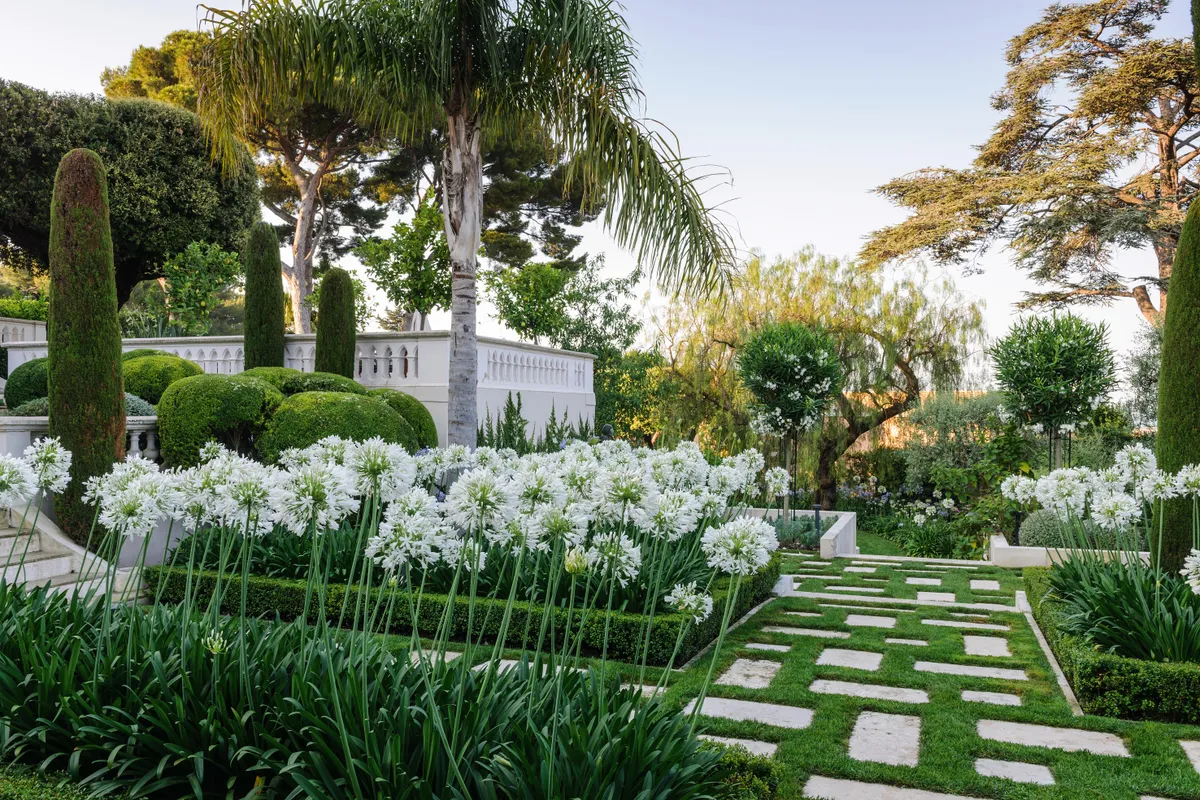IN BRIEF
What Private garden on a sloping site, overlooking the sea. Where Cap d’Antibes, France. Size 2,250 square metres. Soil Heavy soil, improved with volcanic rock for better water retention. Climate Summer temperatures can reach 37°C, and there are strong winds and frequent rain storms all year. Hardiness zone USDA 9.
New beginnings
When landscape architect Ulf Nordfjell first stepped through the metal gates of Villa Lumen, high up on the forested headland of Cap d’Antibes, he was struck by the beauty of the villa with its classical proportions and stunning setting overlooking the Mediterranean. The entrance garden, below the white balustrade that surrounds the villa, was formally laid out, with box-edged beds filled with mainly white agapanthus, and framed with pencil cypresses and clipped myrtles.
But the rest of the garden, which extends from a high point behind the villa and its guest house and drops steeply down the rocky slope, was, in Ulf’s eyes, a mess. “It had typical Riviera garden plants, such as neriums, bougainvilleas and rosemary, and some 100-year-old pines and olives,” he says. “But many of the trees and bushes were diseased and dying, and it was so densely overgrown that you couldn’t make out the garden below.”

The villa is owned by a couple from Stockholm with young children, and Ulf wanted to make a garden they could all use. He was keen to retain as much as he could of the existing planting, including the agapanthus beds and key shrubs, such as those myrtles, rosemary and neriums, and he could see that several of the structural trees, including mature specimens of Schinus molle, Pistacia lentiscus and Quercus ilex, needed to be rescued.

His decision to make the whole garden accessible by creating a series of discrete areas on different levels required challenging landscaping work using the same pale, local limestone for sets of steps, retaining walls and paving stones, which helps to unite the garden. The overgrown area at the back of the villa was transformed into a restful, shady garden full of foliage textures where Australian tree ferns thrive in the shade of lofty palms.

New beds were created to protect the roots of a mature Pistacia, where a feature wall, painted an intense shade of Klein Blue, creates a striking backdrop on the terrace where the family can enjoy al fresco meals, out of the summer heat. From here, the garden drops down in a series of steps to the entrance garden where the agapanthus were removed, divided and replanted, then edged with a more sustainable choice of drought-tolerant Myrsine africana.
Another level
“The whole garden is about working with levels,” says Ulf. “It was important to make comfortable stairs with wide steps and low treads so that they are not difficult for children or anyone wearing high heels.” Ulf’s trademark granite pouffes provide resting places at various points on the way down to the bottom of the garden where an enlarged lawn, which required the replanting of full-grown olive trees and neriums, provides a playing space for the children. At the far end, a tilting pine tree casts dappled shade on a wide terrace inset with a sand pit.

From here, the ascent back up, alongside a rock garden, follows the contours of the natural bedrock and is planted in pockets of soil between rugged boulders introduced to the sun-baked slope. The planting here is a mix of cushion-shaped, drought-tolerant species, such as Centaurea ragusina and Erysimum ‘Bowles’s Mauve’, and succulents such as Mexican Dasylirion serratifolium, Hesperaloe funifera, Aloe x spinosissima and Aloe arborescens. Clipped myrtles and cushions of rosemary
and Westringia create a framework for the more relaxed species.

Ulf studied the flora of the Mediterranean for his 2013 RHS Chelsea Flower Show garden for Laurent-Perrier, and has since seen at first hand the challenges of growing in conditions that, as a result of climate change, mean African heat at the end of May, and year-round, plant-rocking winds and sudden downpours. Through soil improvements, careful selection of plants and restorative tree work by arborists, Ulf and his contractor Franck Delmer have created a garden designed to last. Insect infestations have also been a big problem and part of the maintenance regime is regular inspections by an ecologist and the use of biological controls to minimise damage.

Finishing touches
Clipped evergreens are a unifying feature throughout the various levels and they provide a green framework all year round. Flowering starts in February with jasmine on the boundary walls and aloes and Echium candicans in the rock garden. Roses, on the walls and in a border, bloom in May and again later in the summer while the many standard neriums are spangled with white flowers all summer long. The spectacle of the agapanthus – when he was last visiting Ulf stopped counting at 850 white and 250 blue blooms – lasts for four weeks in midsummer. The garden now offers areas of sun and shade, formality and informality, and a network of floating steps to connect them all.
Useful Information Find out more about Ulf’s work at nordfjellcollection.se


